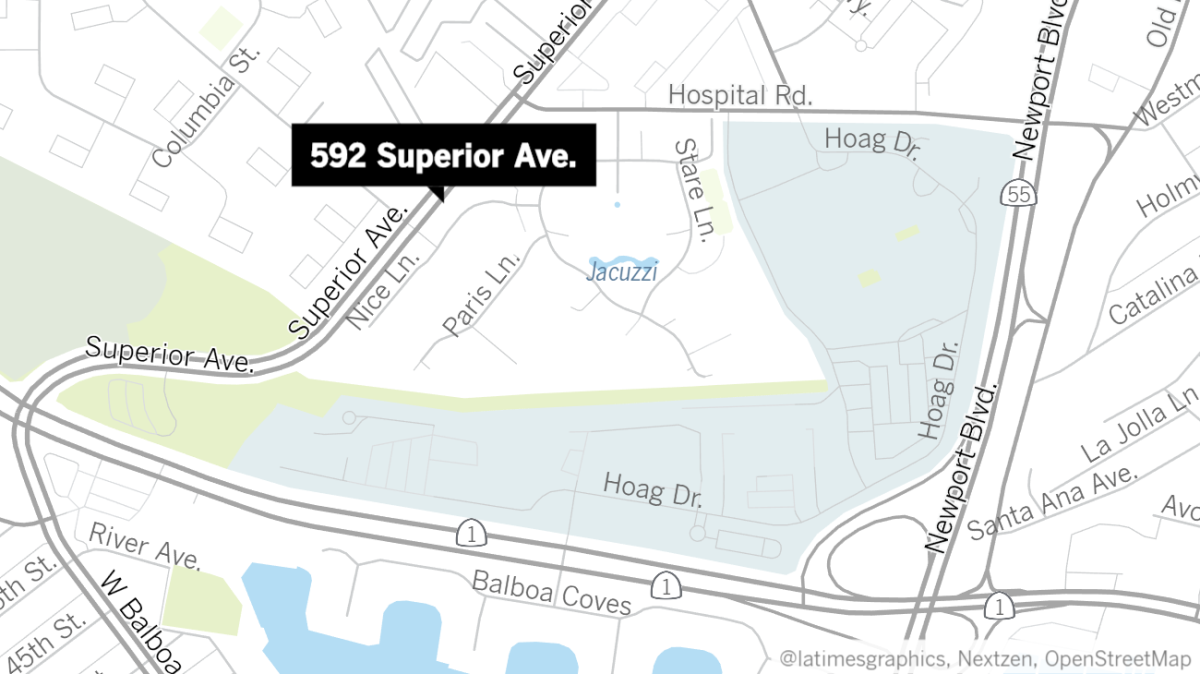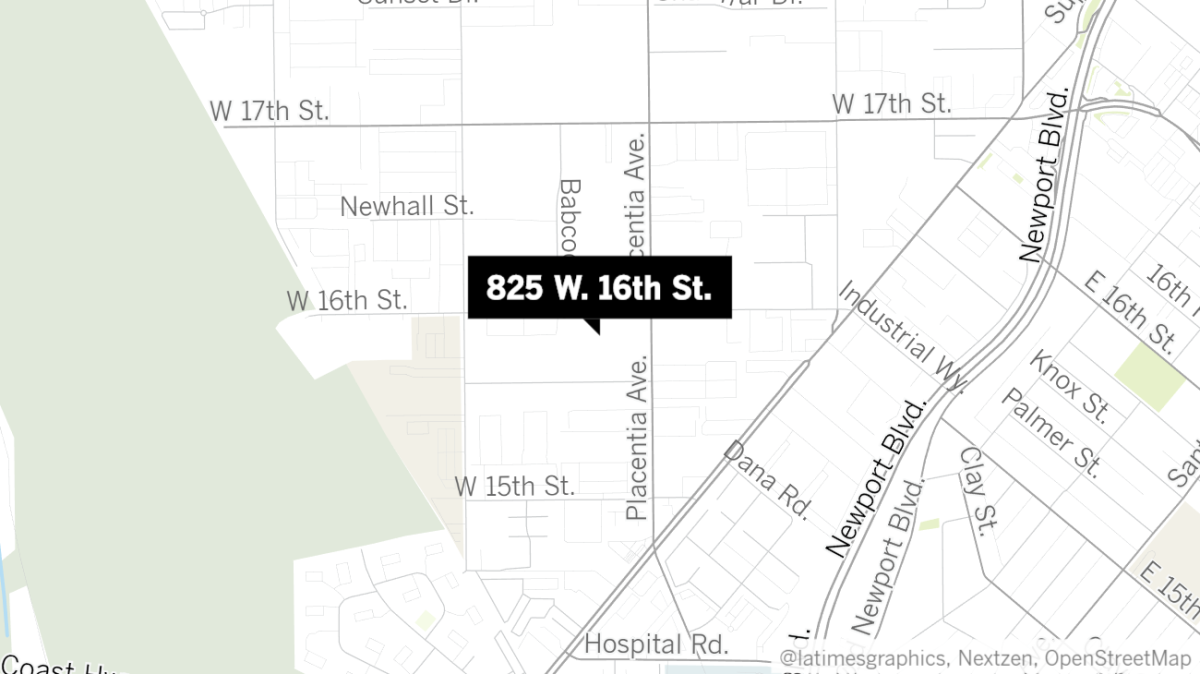Land-use restrictions play into Newport Beach homeless shelter search
- Share via
Even before considering real estate availability and neighbors’ concerns about safety and compatibility, cities must navigate self- and other government-imposed land-use restrictions when building and operating homeless shelters.
As demonstrated in Newport Beach, which is planning a temporary homeless shelter, local zoning codes and preferences and state oversight form rigid guardrails along the path.
Here are the factors in Newport:
Locations and features
After the City Council met Wednesday to begin talks about negotiations for possible sites, the city has three options in mind:
- 4200 Campus Drive, an Avis rental car lot near John Wayne Airport that the city could sublet a portion of
- 592 Superior Ave., a city-owned maintenance yard that could be partially converted for shelter use
- 825 W. 16th St., a vacant warehouse for lease just off Placentia Avenue near Newport’s boundary with Costa Mesa
Newport Beach will not build a homeless shelter on a former motel site, though three other properties are in play.
The council directed city staff to pursue negotiations for the Campus site and research the Superior site. It gave no direction on the 16th Street site, City Attorney Aaron Harp said. However, it was not eliminated, according to Mayor Pro Tem Will O’Neill.
City officials want the shelter to operate on a reservation-only basis, with no walk-ups. It would have around-the-clock security, and occupants would have to prove some kind of connection to Newport Beach, such as prior residency. According to the city zoning code, the shelter would have no more than 40 beds, and occupants could stay up to 14 days.
Zoning considerations
Under a state law in effect since 2008, cities must articulate their homeless populations’ needs and specify where emergency shelters can be built.
Newport Beach tagged the “private institutions” and “office-airport” zoning designations as shelter-appropriate. There, shelters are permitted “by right,” meaning they don’t need a special use permit. They would not be permitted by right anywhere else in town unless those areas were rezoned.
Private institution zoning is on 44 parcels totaling 135 acres around the city. The zone includes churches.
Office-airport zoning is adjacent to John Wayne Airport, covering 56 parcels over 54 acres.
The Campus Drive site is zoned office-airport. The 16th Street location is zoned “industrial,” and the one on Superior Avenue is zoned “public facilities.”
If the city were to choose 16th Street or Superior Avenue, it’s unclear whether it would issue a conditional use permit or rezone the area to office-airport or private institutions.
Why now?
Some other area cities, including Costa Mesa and Huntington Beach, have or are also pursuing new homeless shelters. The recent surge comes with prompting from U.S. District Judge David Carter, who has presided over lawsuits filed around Orange County by homeless advocates. Carter has repeatedly urged county and city officials to develop plans for expanding the number of emergency shelters and to not enforce local anti-camping bans or cite homeless people for sleeping or setting up camp in public if there are no shelters nearby.
A 2018 ruling by the U.S. 9th Circuit Court of Appeals restricts cities from prosecuting people for sleeping on public property if no shelter beds are available. That means Newport Beach, like other cities in the West, is constrained on how it can clear homeless people from the streets and must offer shelter before it can enforce anti-camping laws.
“My sole goal in pushing for ... these locations, along with Mayor [Diane] Dixon and other members of the council, is purely to bring safety to the streets,” Councilman Kevin Muldoon said this week.
In addition, homelessness is becoming more visible in Newport Beach. Encampments, especially at the municipal piers and the public bus depot at San Joaquin Hills Road and MacArthur Boulevard, have prompted residents to give the city heated feedback.

Spots near the water
Contradicting designations may serve to eliminate some properties from shelter consideration.
The council scratched the former site of the Pine Knot Motel at 6302 W. Coast Hwy., which is in the state-designated coastal zone, potentially making it subject to a lengthy review by the California Coastal Commission.
City Manager Grace Leung showed the capacity crowd Wednesday a color-coded city map that she said illustrates major competing land-use challenges. The coastal zone was indicated in blue, orange spots showed a discretionary 500-foot buffer around schools, and purple indicated the zoning districts deemed shelter-appropriate.
Nearly half the city is within the coastal zone, which doesn’t prohibit development closest to the water but does subject it to more scrutiny. The city can issue development permits, but the last word may rest with the Coastal Commission.
“While we have it in our powers to permit a shelter, anything in the coastal zone can be appealed to the Coastal Commission … and once that happens it would have to be heard and dealt with by the Coastal Commission, which could take several months and could potentially be denied,” Leung said.
Even with the council’s assurance that the motel — which burned down in April 2018 but hasn’t been razed and is currently fenced — will not be a shelter, residents of the adjoining Newport Shores neighborhood were critical.
“We shouldn’t be here today,” Ryan Long, a board member for the Newport Shores Community Assn., told the council Wednesday. “The Pine Knot should never have been put on this [list]. The city and the staff need to do a better job supporting its residents before wasting all this energy, time and money.”

Proximity to schools
Nothing in the city zoning code or the state law requiring cities to zone for shelters mentions a buffer area around schools, but Newport Beach drew one, prohibiting such uses within 500 feet of schools and knocking some areas otherwise zoned for shelters out of consideration.
The 16th Street site is about a quarter-mile from Carden Hall, a private elementary and middle school. The private Pacifica Christian High School is within about a half-mile. That puts both schools outside the 500-foot radius.
However, Christy Jones Kalthoff, Carden Hall’s executive director and owner, said the mixed-use neighborhood isn’t a good fit for a shelter.
“Our children, our most precious upcoming young assets, and homeless people are not two constituencies that ought to be in close proximity,” she said.
What’s next
Newport Beach resident Bill Ashmore lambasted the city’s process so far as “amateurish” and embarrassing. He said he would have fired city staff if it worked for him.
Leung acknowledged that “there is no perfect site. There are issues with every single site to consider.”
The city wanted to move as quickly as possible to balance needs with limited options, “knowing all options had negatives to them, and admittedly some more than others,” she said.
The city also will explore possible regional solutions such as sharing a facility with a neighboring city.
The next meeting of Newport’s homelessness task force is at 4 p.m. Sept. 17 at a location to be announced.
All the latest on Orange County from Orange County.
Get our free TimesOC newsletter.
You may occasionally receive promotional content from the Daily Pilot.










